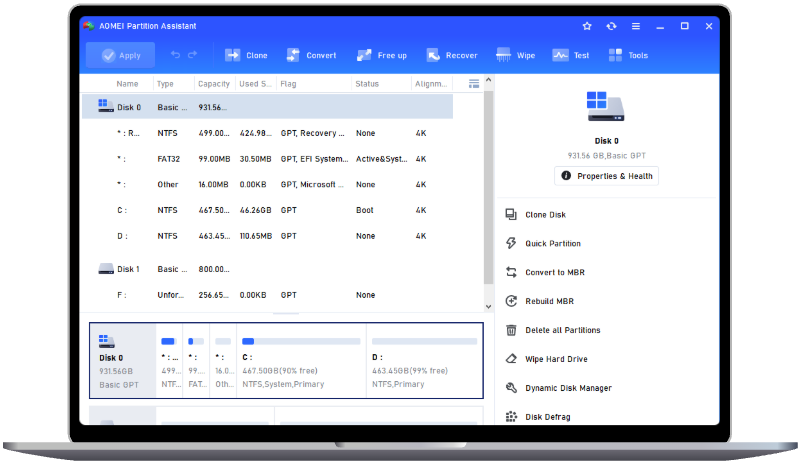Full Guide: Windows Drive Clone to SSD on Windows 11/10
Cloning your Windows drive to an SSD is an effective way to enhance your computer’s speed and performance. This guide will walk you through the process of Windows drive clone to SSD or the entire system disk to SSD in Windows 11/10/8/7.
Why need Windows drive clone to SSD?
Upgrading from HDD to SSD is one of the best ways to boost your PC’s speed and performance. Instead of reinstalling Windows and all your programs from scratch, you can simply clone your Windows drive to the new SSD. But why is this necessary? Let’s explore the key reasons why cloning your Windows drive to an SSD is a smart move.
1. Boost system performance
SSDs are significantly faster than traditional HDDs. Performing your Windows drive clone to SSD reduces boot times, speeds up application launches, and improves overall system responsiveness. If your PC feels sluggish, upgrading to an SSD can make it run like new.
2. Save time and effort
Reinstalling Windows from scratch means setting up drivers, reinstalling software, and restoring personal files. Cloning your drive allows you to skip this tedious process, keeping everything intact—including your settings, applications, and files.
3. Avoid data loss
Manual data transfers can lead to missing or corrupted files. By cloning your drive, you create an exact replica of your system, ensuring that no important data is lost during the upgrade.
4. Extend your laptop’s lifespan
If your laptop still uses an HDD, switching to an SSD can significantly extend its usability. SSDs generate less heat, consume less power, and are more durable than HDDs, making them ideal for older laptops.
5. Improve gaming and software performance
For gamers and professionals using heavy software like video editors or 3D design tools, an SSD dramatically reduces load times and enhances overall performance, making your workflow smoother and more efficient.
6. Enhance reliability and durability
SSDs have no moving parts, making them more resistant to physical damage compared to HDDs. If your laptop or desktop frequently moves around, an SSD is a more reliable storage solution.
Best software to make Windows drive clone to SSD
Upgrading from an old hard drive to a new SSD is one of the best ways to boost your PC’s performance. However, reinstalling Windows and transferring all your files manually can be time-consuming and complicated. That’s where drive cloning software comes in.
If you're looking for the best tool to clone Windows 10 drive to new SSD effortlessly, AOMEI Partition Assistant is one of the top choices. It is a powerful and user-friendly disk management tool that simplifies the process of cloning a Windows drive to an SSD.
Key features of AOMEI Partition Assistant for disk cloning:
▼ Disk Clone Wizard: Easily clone an entire hard drive, including the operating system, installed programs, and personal files.
▼ Migration OS: Move only the Windows system partition to an SSD, ideal for keeping OS files separate from personal data.
▼ Sector to Sector Clone: It can create an exact replica of the original disk, ensuring all data is preserved.
▼ Copy Disk Quickly: It copies only used space, allowing you to clone a larger HDD to a smaller SSD.
▼ 4K Alignment: With it, AOMEI Partition Assistant ensures SSD performance and lifespan are maximized after migration.
▼ Make Bootable Media: This disk cloning tool can also help clone disks even if your system fails to boot.
2 ways to perform Windows drive clone to SSD
Cloning your Windows operating system to an SSD can significantly boost performance and reduce boot times. Below, you'll find two methods to achieve this. First, download the demo version of the cloning software, then follow the step-by-step guide.
Preparations before cloning
To ensure a smooth cloning process, take the following precautions:
• Backup your system – Unexpected issues like power failures can occur. Create a full backup to prevent data loss.
• Save important data elsewhere – Cloning will erase all data on the SSD. Move any crucial files to another storage device beforehand.
• Optimize your system drive – Since SSDs typically have less storage than HDDs, shrink your system partition to fit the SSD more efficiently.
• Connect the SSD to your computer – Ensure the SSD is properly attached and detected before proceeding.
>> For desktop users, open the computer case and connect the SSD to the motherboard.
>> For laptop users, use a USB adapter to connect the SSD via a USB port.
Once these steps are completed, you can begin the Windows drive clone to SSD.
Method 1. Clone Windows system disk to SSD
If you need to clone the entire Windows system disk to SSD, try “Clone Disk”.
Step 1. Install and launch AOMEI Partition Assistant, click "Clone" in the main interface, and select "Clone Disk".
Step 2. Choose the hard disk that you need to clone as the source disk and click "Next".
Step 3. Select another drive as the destination disk, and then click "Next".
Step 4. Then, you can check the source and destination disk in the next window or change to "Sector to Sector clone", and click the "Confirm" button to continue if there is no problem.
Here, you can also click the "Settings" button to adjust the partition size on the destination disk or tick "4k alignment" to improve the reading and writing speed of the SSD.
Step 6. You can preview the disk cloning operation by viewing the "Pending Operations". To commit the "Pending Operations", please click "Apply" and "Proceed".
Method 2. Clone only Windows OS to SSD
If you want to clone only the Windows system partition to SSD, try “Migrate OS” Wizard.
Step 1. Install and open AOMEI Partition Assistant. Choose "Clone"> “Migrate OS” in the top panel and click “Next” in the pop-out window.
Step 2. Choose an unallocated space on the SSD drive. If there are partitions on it, tick "I want to delete all partitions..." to generate unallocated space and click “Next”.
Step 3. In this window, you can resize partition as you need, then click “Next”.
Step 4. A note on how to boot from the destination disk will appear, read it carefully and click “Finish”.
Step 5. Click “Apply” to commit the Windows 10/8/7 system clone to SSD operation.
Conclusion
AOMEI Partition Assistant offers a seamless way to perform Windows drive clone to SSD, allowing you to boot from the new drive effortlessly. Additionally, if you need a portable Windows environment, the "Windows To Go Creator" feature enables you to copy your system to a USB drive, making it easy to carry and use anywhere. For users looking to migrate a Windows Server OS to another HDD or SSD, AOMEI Partition Assistant Server provides a specialized solution tailored for server environments.


